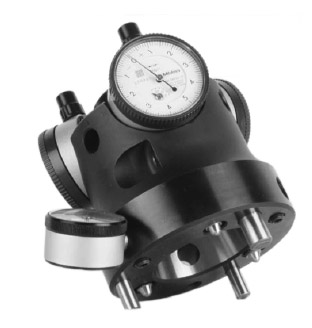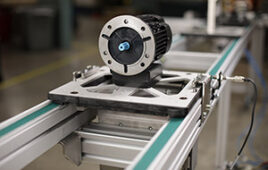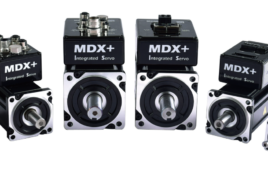 An important part of CNC milling is the v-flange toolholder–which impacts the performance of the cutting tools and the machine itself. A critical factor in toolholder performance is the surface area contact between the large end of the toolholder and the spindle, which is essential for tool rigidity. A higher percentage of taper contact with the spindle at the large end and moving up the taper toward the small end results in improved cutting performance and over-all milling results. Less than 75% taper contact with the spindle results in poor T.I.R. (runout), poor tool life, poor tolerances, vibration and chatter, poor finishes, and excessive spindle wear and tear.
An important part of CNC milling is the v-flange toolholder–which impacts the performance of the cutting tools and the machine itself. A critical factor in toolholder performance is the surface area contact between the large end of the toolholder and the spindle, which is essential for tool rigidity. A higher percentage of taper contact with the spindle at the large end and moving up the taper toward the small end results in improved cutting performance and over-all milling results. Less than 75% taper contact with the spindle results in poor T.I.R. (runout), poor tool life, poor tolerances, vibration and chatter, poor finishes, and excessive spindle wear and tear.
In an effort to ensure optimal mill productivity and tooling performance, JM Performance Products Inc. developed the Taper Shank Test Fixture, to check toolholders and test for taper deformation.
A growing area of concern with use of modern CNC machines with upwards of 500 tools, is tooling cost containment and optimal tooling performance. Unfortunately when a standard retention knob is installed into a toolholder, it can expand the small end of the taper of the toolholder. This expansion can reduce toolholder to spindle contact by 70% or more, resulting in loose tool situations.
The end result is that it will no longer meet ISO 1947 angular taper tolerance (AT) specifications “AT3 or better” for toolholders. Retention knob expansion prevents toolholders from properly seating within the spindle, which can result in vibration and chatter issues that negatively impacts tool life, especially expensive carbide tools. It also impacts milling at the actual production level; most companies are running machines 20-40% slower than they should in order to preserve their tools and get required accuracy and finishes.
An often over-looked safety hazard also exists. As the tool is rotating in excess of 8,000 rpms, the movement of the holder within the spindle is applying enormous stress to the retention knob that is holding it in the spindle. What many shops don’t realize is that stress can cause failure of the retention knob, resulting in the toolholder and tool breaking loose from the spindle during a cutting operation.
Besides damage to the spindle, tool, holder, and workpiece, the velocity of the tool when it breaks loose also represents a real injury threat to the operator.
Additional considerations for toolholder expansion include:
▪ Carbine tool life is diminished by 50% for every .0005” distance short of full engagement between the
toolholder and spindle.
▪ Toolholders may begin to expand with as little as 15 ft/lbs of torque. ▪ Toolholders showing more than .0002” growth have not been hardened adequately and should not be used!
The Taper Shank Test Fixture quickly checks toolholders for distortion caused by retention knob installation.
Development of the patented product was key to identifying the inherent flaw design in v-flange tooling. This discovery was ultimately the driving force for the creation of their patented High Torque retention knobs, which are longer than traditional knobs and feature a precision pilot to increase rigidity, and a relief below the flange that forces threads into a deeper cross section of the toolholder. This eliminates the toolholder expansion responsible for costly and ongoing CNC milling and boring issues.
Key integrated design features include:
▪ Precision gages that read in increments of 1/10,000 of an inch.
▪ Ground to mirror a machine spindle.
▪ Three top dial indicators read the height off the flange and two side dials read taper movement.
▪ Sizes: 30 / 40 / 45 / 50 / 60 Taper
Proper retention knob installation is crucial to toolholder performance. Overtightening the retention knob may damage and unnecessarily stress the knob leading to premature failure. It also exacerbates the effects of toolholder expansion. A quick, simple test using the Taper Shank Test Fixture can be performed on a toolholder with a retention knob already installed.
Following the manufacturer’s instructions to fit the fixture and zeroing out the indicators for a base reading, and then loosening the knob for a second reading, will return an immediate indication of whether or not the holder has experienced expansion. The good news is that an expanded toolholder does not need to be removed from service and scrapped. Once the retention knob has been removed, the toolholder should return to its original state and can be used with a High Torque knob tightened to the correct torque spec.
When the toolholder taper is deformed, it prevents the toolholder from properly seating within the spindle. The ‘elastic zone’ at the small end makes contact with the spindle before the large end of the taper is engaged. This reversal of contact allows the toolholder to move at the gage line. Ultimately, this movement at the gage line is what produces fretting marks found on the toolholder and a laundry list of milling issues.
According to JMPP President, John Stoneback, “It’s important to note that all v-flange tooling is designed to fit the spindle taper within tolerances of twenty-nine-millionths of an inch (0.000029-in.). Tests performed using the Taper Shank Test Fixture revealed a significant advantage for our High Torque retention knobs vs. standard knobs. In fact, most of our clients experience a 20-80% performance advantage.”
JM Performance Products Inc.
www.jmperformanceproducts.com
Filed Under: MOTION CONTROL




